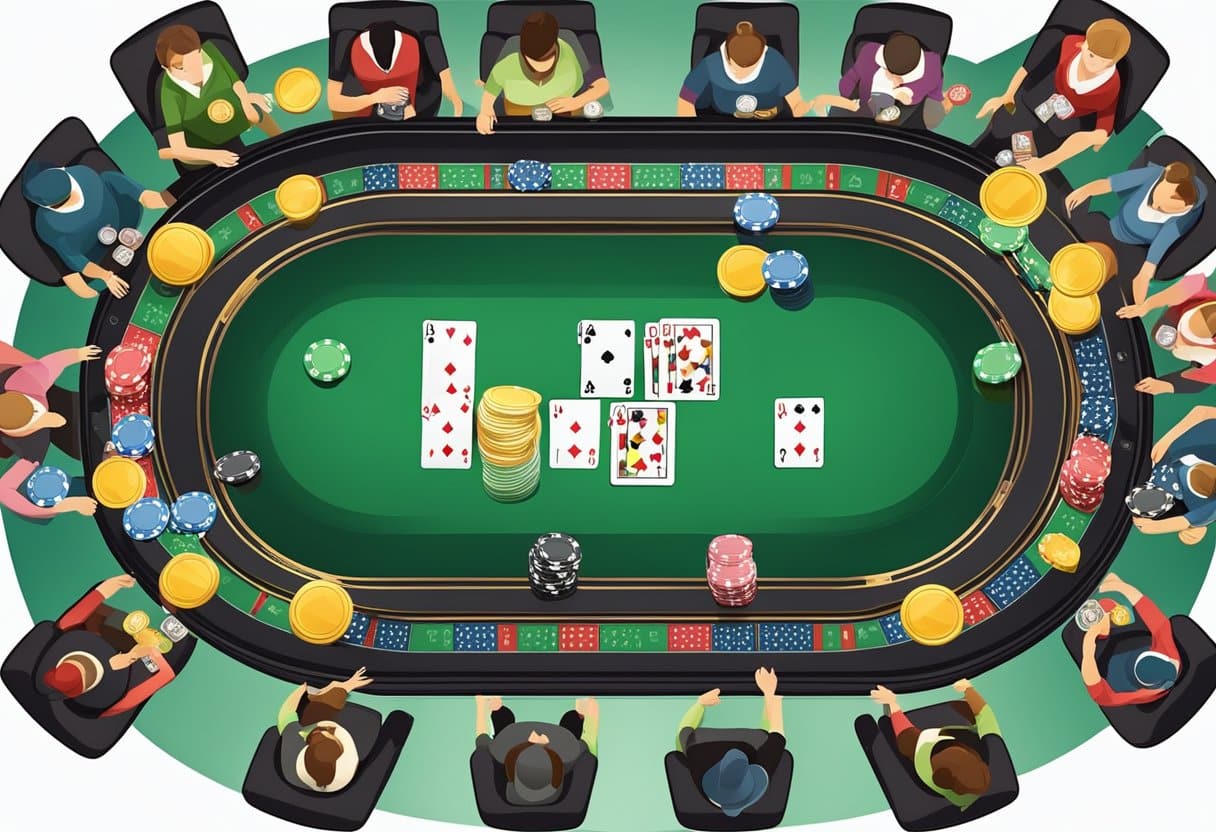Understanding different poker player types is the key to increasing your profits at the table. While many players focus on perfecting their own strategy, truly successful poker players adapt their approach based on their opponents’ tendencies and weaknesses.
The most profitable poker strategy in 2025 remains identifying and exploiting the four main player types: tight-passive, loose-passive, tight-aggressive, and loose-aggressive.

By recognizing whether your opponent is passive or aggressive, tight or loose, you can adjust your game to directly counter their playing style and maximize your edge.
For example, against passive players who don’t fold enough, you can value bet thinner and bluff less. When facing overly aggressive opponents, you can trap more effectively and call down lighter with medium-strength hands.
Each player type exhibits distinct patterns in their betting, raising, and folding frequencies. The ability to quickly categorize opponents at the table allows you to make better decisions without needing to gather extensive history on each player.
This adaptive approach is especially valuable in live poker environments where you might have limited information about your opponents.
Understanding the Fundamentals of Poker

Before exploiting different player types, you need a solid grasp of poker basics. The foundation of strategic play includes knowing the game’s history, understanding various formats, and recognizing hand strengths.
The History and Evolution of Poker
Poker’s origins trace back to the early 19th century along the Mississippi River. The game evolved from simpler gambling pastimes into the complex strategic challenge we know today.
In the 1970s, poker gained mainstream popularity with the World Series of Poker. Texas Hold’em emerged as the dominant variant during this period, largely due to its balance of simplicity and strategic depth.
The internet revolution of the early 2000s transformed poker again. Online platforms made the game accessible to millions, creating a boom that introduced concepts like GTO (Game Theory Optimal) strategy.
Today’s poker scene blends traditional live play with online innovations. Modern players benefit from advanced training tools and analytics that weren’t available to earlier generations.
Understanding the Rules of Different Game Formats
Texas Hold’em remains the most popular poker format. Players receive two private cards and use five community cards to make their best hand.
Omaha adds complexity by dealing four private cards to each player. The key rule: you must use exactly two of your hole cards and three community cards to make your hand.
Seven-Card Stud differs significantly from the above formats. Players receive seven cards throughout the hand – three face down, four face up – with no community cards.
Each format requires different strategies. Hold’em rewards positional awareness, Omaha favors drawing to the nuts, and Seven-Card Stud demands careful tracking of exposed cards.
Assessing Different Poker Hands and Their Strengths
Hand strength in poker follows a standard hierarchy:
| Rank | Hand Type | Example |
|---|---|---|
| 1 | Royal Flush | A♥ K♥ Q♥ J♥ 10♥ |
| 2 | Straight Flush | 8♠ 7♠ 6♠ 5♠ 4♠ |
| 3 | Four of a Kind | Q♥ Q♦ Q♣ Q♠ 7♣ |
| 4 | Full House | J♥ J♦ J♣ 9♥ 9♣ |
| 5 | Flush | A♦ J♦ 8♦ 4♦ 2♦ |
Starting hands vary in value based on game format. In Hold’em, premium hands include pocket aces, kings, and suited connectors like J♥10♥.
Hand strength is always relative to the board and opponents’ likely holdings. The “nuts” refers to the best possible hand at any point, which smart players constantly recalculate.
Speculative hands like small pocket pairs or suited connectors have less immediate value but can win big pots when they connect with favorable community cards.
Dynamics of Player Types in Poker
Understanding player types in poker gives you a significant edge at the table. Recognizing patterns in how opponents play allows you to adjust your strategy and exploit their weaknesses.
Categorizing Poker Player Types
Poker players typically fall into several distinct categories based on their playing style. Tight-aggressive players (TAGs) play few hands but bet strongly with those they choose. They’re selective but forceful when involved in a pot.
Loose-aggressive players (LAGs) play many hands and bet frequently, creating constant pressure. They’re unpredictable and can be challenging opponents.
Nits are extremely conservative players who fold most hands and only play premium holdings. They rarely bluff and can be exploited by aggressive betting.
Calling stations call too frequently and rarely raise. They struggle to fold medium-strength hands and can be profitable targets.
Maniacs play almost any two cards and bet aggressively without regard for hand strength. Their volatility creates opportunities but requires caution.
Psychological Profiles and Tendencies
Player psychology dramatically impacts poker decisions. Emotional players often go on tilt after bad beats, making them susceptible to mistakes. Watch for signs like faster betting, increased aggression, or visible frustration.
Risk-averse players avoid confrontation and often check when they should bet. They frequently fold to aggression and can be bluffed consistently.
Pattern-dependent players follow predictable routines in similar situations. Many recreational players act quickly with strong hands and delay with marginal holdings.
Image-conscious players worry about how others perceive them. They’ll make suboptimal plays to maintain their table reputation.
Understanding these psychological tendencies allows you to predict reactions and adjust accordingly.
Reading body language, timing tells, and betting patterns reveals valuable information about opponents’ mental states and likely holdings.
Strategic Approaches to Live Poker
Successfully navigating live poker requires a blend of fundamental strategies, precise bet sizing, positional awareness, and exploitative techniques. Different situations call for different approaches, and knowing when to adjust your play can make the difference between winning and losing.
General Poker Strategies and When to Use Them
Every poker player needs a foundation of core strategies to build upon. Tight-aggressive (TAG) play works well in most live environments, especially against recreational players. This involves playing fewer hands but betting and raising when you do participate.
In games with many calling stations, value betting becomes your primary profit source. Extract maximum value from your strong hands against players who call too frequently.
Against aggressive opponents, pot control and trapping become more effective. Let them bluff into your strong hands instead of scaring them away with your bets.
Table selection is crucial in live poker. Look for tables with at least 2-3 weaker players to ensure profitability. The best strategy is often finding the right game rather than trying to beat tough opponents.
Balance your play with occasional mixed strategies to avoid becoming predictable. This means sometimes checking strong hands or bluffing with weak ones.
Bet Sizing and Tactical Betting
Bet sizing is a powerful tool in live poker. Here are key approaches to consider:
- Standard sizing (2.5-3x preflop raises) works well against average players
- Larger preflop raises (4-5x) when in position against loose players
- Smaller c-bets (50-60% pot) on dry flops when you have position
- Larger c-bets (75-100% pot) on wet flops to deny equity
Your bet sizing should tell a consistent story throughout a hand. Recreational players often bet small with strong hands to “keep opponents in.” Use this knowledge to your advantage.
Thin value betting becomes profitable against calling stations. Extract value in spots where you might otherwise check back against better players.
Vary your bet sizing occasionally to avoid giving away information. Some players always bet big with bluffs and small with value hands or vice versa.
Positional Play and Its Importance
Position is one of the most powerful advantages in poker. In late position (button, cutoff), you can play significantly more hands than from early positions.
When in position, you:
- See your opponent’s actions first
- Can control pot size more effectively
- Make more accurate decisions with more information
- Can bluff more profitably
From out of position, tighten your ranges and play more straightforward. Value bet strong hands and check-fold marginal holdings more often.
The blinds require special consideration. Defend your big blind against late position opens more liberally, but be prepared to play carefully post-flop when out of position.
Position affects every decision you make. A hand like KJ might be a raise from the button but a fold from under the gun. Remember that your positional advantage compounds throughout the entire hand.
Leveraging Pot Control and Exploitative Play
Exploitative play forms the backbone of profitable live poker. Rather than playing a balanced GTO style, you’ll make more money by directly countering opponents’ mistakes.
Against passive players:
- Value bet thinner
- Bluff less frequently
- Size bets larger with strong hands
When facing aggressive players:
- Check-raise more often
- Trap with strong hands
- Call down lighter with medium-strength hands
Pot control is essential when playing marginal hands or when out of position. Sometimes checking back the flop or turn with medium-strength hands preserves the pot size and lets you get to showdown more cheaply.
Deception has its place in live poker. Occasionally mixing in check-raises with strong hands or check-calling with drawing hands can make you harder to read. However, against recreational players, straightforward play is usually more profitable.
Always remain aware of betting patterns at your table. Most live players have obvious tells in their timing and sizing that you can exploit for additional profit.
Advanced Concepts in Poker Strategy
Moving beyond basic poker fundamentals opens up a world of strategic depth that can significantly improve your win rate. These advanced concepts require deeper analysis and adaptability at the table.
Understanding and Applying Game Theory Optimal (GTO)
Game Theory Optimal (GTO) play represents a mathematically balanced approach that’s theoretically unexploitable. This strategy focuses on making decisions that maximize expected value regardless of opponent tendencies.
Modern poker players often use GTO solvers like PioSOLVER or SimplePostflop to study optimal play. These tools calculate perfect frequencies for betting, checking, calling, and raising in different scenarios.
Key GTO principles include:
- Balanced ranges: Having the right ratio of value hands to bluffs
- Mixed strategies: Sometimes calling, sometimes raising with the same hand
- Proper bet sizing: Using mathematically sound bet sizes based on pot and stack depth
GTO isn’t about winning every hand but making decisions that yield profit over time. Even top professionals can’t play perfect GTO poker, but understanding these concepts provides a solid foundation for advanced play.
Exploitative Strategies for Different Types of Opponents
While GTO provides an unexploitable baseline, exploitative play often generates higher profits against specific player types. This approach intentionally deviates from GTO to capitalize on opponents’ mistakes.
Against tight-passive players:
- Bluff less frequently
- Value bet thinner
- Steal their blinds aggressively
When facing loose-aggressive opponents:
- Call wider with medium-strength hands
- Trap more with premium holdings
- Let them bluff into your stronger ranges
The key to exploitative play is careful observation. Track betting patterns, timing tells, and emotional reactions. Adjust your strategy when you notice consistent errors like overfolding, overcalling, or predictable c-betting.
Remember that exploitative play makes your own strategy potentially exploitable. Be prepared to readjust when opponents adapt to your adjustments.
Adjusting Play for Tournaments vs. Cash Games
Tournament and cash game strategies differ significantly due to their structural differences. In tournaments, chip preservation and accumulation follow different patterns than in cash games.
Tournament considerations:
- Stack-to-blind ratios impact decision-making more than absolute stack size
- ICM (Independent Chip Model) affects optimal play, especially near bubble situations
- Antes and escalating blinds create pressure to accumulate chips
Cash game dynamics:
- Deep stack play allows for more post-flop maneuvering
- Table selection becomes critically important
- You can reload at any time, reducing the need for chip preservation
In tournaments, players must adapt as structures change. Early stages permit patient play, while middle stages require more aggression. Late stages demand understanding of short-stack push/fold dynamics.
Cash games reward consistent technical proficiency and emotional control during long sessions. Your ability to maintain focus while identifying and exploiting opponents’ tendencies determines long-term success.
Mastering the Mental Game of Poker
The mental aspect of poker often separates good players from great ones. Strong technical skills mean little if a player cannot maintain emotional control and commit to ongoing improvement.
Emotional Control and Dealing with Tilt
Tilt is a poker player’s worst enemy. It occurs when emotions override logical decision-making, leading to poor choices and lost money.
Players should develop a simple tilt control system. This might include taking deep breaths, stepping away from the table, or using a mental reset phrase.
Variance is inevitable in poker. A player might make the right decision and still lose. Understanding this helps prevent emotional reactions to bad beats.
Pre-game preparation matters. Players who are well-rested and in a good mental state handle pressure better than those who are tired or stressed.
As Jared Tendler, mental game coach to professional poker players, suggests, recognizing your emotional triggers is the first step toward controlling them.
Continuous Improvement Through Study and Training
Successful poker players commit to lifelong learning. They study hand histories, analyze their play, and identify leaks in their strategy.
Training should be structured and consistent. Set aside regular time to review concepts, study new strategies, and practice implementation.
Many players benefit from joining study groups or hiring coaches. Outside perspectives often spot weaknesses that self-analysis misses.
Use these study resources:
- Hand analysis software
- Strategy books and videos
- Online forums and discussion groups
- Coaching sessions
Track your progress with data. Record your results, note strategic adjustments, and measure improvement over time.
Balance study with play. Theory without practice has limited value, while playing without study means repeating the same mistakes.
Practical Tips for Live Poker Success
Moving from theory to practice requires mastering key skills beyond just understanding player types. These practical tips can significantly improve your live poker results through proper money management, reading physical cues, and making the transition from online play.
Effective Bankroll Management
Successful poker players treat their poker money as a business investment, not gambling funds.
For cash games, maintain a bankroll of at least 20-30 buy-ins for your regular stakes. This buffer protects against inevitable downswings and variance.
Consider moving down in stakes temporarily when your bankroll drops below 20 buy-ins. This prevents the common mistake of “playing scared” with money you can’t afford to lose.
Track every session with simple notes on stakes, hours played, and results. Many players use poker tracking apps to monitor their win rates and identify leakage in their game.
Set clear stop-loss limits for each session (typically 2-3 buy-ins) to prevent emotional decisions after losses. Similarly, establish win goals to help you leave the table when you’re ahead.
Body Language and Physical Tells
Physical tells provide valuable information unavailable in online poker.
Watch for timing tells – quick calls often indicate weakness, while hesitation before raising frequently signals strength.
Pay attention to breathing patterns. Many players breathe faster when holding strong hands and may even hold their breath during crucial moments.
Hand movements can reveal nervousness. Shaking hands typically indicate either extreme nervousness or excitement about a strong holding.
Common reliable tells:
- Staring at chips (planning a bet)
- Sudden stillness (often strong hands)
- Looking away immediately after seeing cards (usually strong)
- Excessive chip shuffling (often covering nervousness)
Focus on pattern recognition rather than isolated incidents. The most reliable tells appear when players are under pressure and not consciously controlling their behavior.
Adapting to Live Play After Online Poker
Live poker moves much slower than online, with about 30 hands per hour versus 100+ online.
Use this extra time to observe opponents rather than checking your phone.
Verbalize your actions clearly (“raise to $25”) to avoid string betting and other technical mistakes that don’t exist online.
Remember that live players generally play looser and more passively than online opponents. You’ll face fewer 3-bets but more callers, requiring adjustments to your bluffing frequency.
Key adjustments:
- Value bet thinner than online
- Bluff less frequently against multiple opponents
- Size your bets larger (many live players call regardless of size)
Prepare for more emotional swings in live settings where losses happen face-to-face. Develop techniques to stay focused during hours of play without the convenience of auto-dealing and time banks.
Incorporating Technology in Poker
Technology has revolutionized poker strategy, giving players powerful tools to analyze games and make better decisions. Modern players use various digital resources to gain an edge over their opponents.
Using Poker Software and HUDs to Analyze Play
Poker tracking software like PokerTracker and Holdem Manager has transformed how serious players approach the game. These programs collect and organize hand histories, allowing players to review their own play and identify leaks in their strategy.
Heads-Up Displays (HUDs) overlay real-time statistics on opponents during online play. Common stats include VPIP (voluntarily put money in pot), PFR (pre-flop raise), and 3-bet percentages. These numbers reveal player tendencies and help categorize opponents into types.
For example, a player with 45% VPIP and 10% PFR likely falls into the “calling station” category. This information lets you adjust your strategy accordingly.
Some poker sites prohibit HUDs, but the analytical skills developed through using them can transfer to live play through careful observation.
Equity Calculators and Their Applications
Equity calculators determine the mathematical expectation of hands in various scenarios.
Tools like Equilab and Flopzilla help players understand their equity against opponents’ ranges.
These calculators serve multiple purposes:
- Pre-flop analysis: Calculating hand strength in various positions
- Post-flop evaluation: Determining continuation bet profitability
- Expected value calculations: Making mathematically sound decisions
By inputting likely opponent hand ranges, players can determine optimal bet sizes and identify +EV (positive expected value) situations.
For tournament players, ICM calculators add another dimension by factoring in payout structures when calculating optimal pushing and calling ranges.
Regular practice with these tools develops intuition that carries over to live play where technology isn’t directly accessible.
Exploring Different Poker Environments
Poker can be played in various settings, each with unique challenges and opportunities for strategic exploitation. Understanding these environments helps players adapt their approach to maximize profits.
Taking Advantage of Online Poker Platforms
Online poker platforms like PokerStars offer distinct advantages for strategic players. These sites provide access to a wider pool of opponents with varying skill levels, making table selection crucial for profit.
Many online platforms feature detailed statistics tracking VPIP (Voluntarily Put Money In Pot) and other metrics that help identify exploitable players. This data-driven approach isn’t available in live settings.
User-friendly interfaces allow multi-tabling, increasing hourly earnings potential. Most sites offer various game formats from full ring (9-10 players) to heads-up play.
Online casinos typically provide lower stakes options, perfect for building skills before moving to higher limits. The anonymity of online play also gives an advantage to observant players who can track patterns without revealing their own tendencies.
Climbing the Ranks in Live Tournaments
Live tournaments require different exploitation strategies than cash games. Players must adjust to changing stack depths and increasing blinds throughout the event.
Tournament play rewards patience and aggression at key moments. Early stages allow observing opponents’ tendencies without risking significant chips.
Professional poker players often excel in tournaments by adapting to table dynamics. As fields narrow, understanding ICM (Independent Chip Model) becomes essential for making optimal decisions.
Live tournaments feature leaderboards and provide networking opportunities with other serious players. The physical tells available in live play add another layer of information not accessible online.
Success stories in tournaments often come from players who master both technical skills and psychological warfare.
The Importance of Community and Learning From Others
Poker communities provide valuable resources for improving exploitation skills. Online forums, training sites, and study groups offer perspectives on different player types.
Discussing hands with other skilled players helps identify blind spots in your strategy. Many professional players attribute their success to collaborative learning environments.
Finding a community that matches your goals and playing style can accelerate improvement. Some focus on GTO (Game Theory Optimal) play while others emphasize exploitative approaches.
Regular participation in community discussions keeps players updated on evolving strategies. Sharing success stories and learning experiences creates a supportive environment for growth.
Communities also provide emotional support during inevitable downswings, helping maintain proper mindset for exploitative play.
Specific Strategies for Poker Variants
Different poker variants require unique approaches to exploit player types effectively. Each game format demands specific strategies tailored to its rules and betting structures.
Texas Hold’em Strategies from Opening to River
Position matters tremendously in Texas Hold’em. Early position players should adopt tighter ranges, while late position allows for more exploitation of passive opponents.
Pre-flop Strategy: Target tight players by raising with a wider range when they’re in the blinds. They often fold too frequently, giving you immediate profit.
Flop Strategy: Against aggressive players, check-raise more frequently with strong hands. They’ll often bet with weak holdings, allowing you to build the pot.
Turn and River Play: Use pot odds calculations to make profitable decisions. When facing calling stations, value bet thinner than normal—they’ll pay you off with weaker hands.
For overly aggressive opponents, implement a “rope-a-dope” strategy by checking strong hands and letting them hang themselves with bluffs.
Navigating the Complexities of Omaha Strategies
Omaha requires adjusting your thinking since players hold four cards instead of two. This dramatically changes hand values and potential.
Key Adjustments:
- Play tighter pre-flop than in Hold’em
- Focus on hands with coordination and connectedness
- Be wary of “trap hands” that look strong but have limited potential
Against loose players in Omaha, tighten your starting requirements and capitalize on their tendency to play too many hands. Wait for premium starting hands with multiple ways to make the nuts.
When facing tight players, increase your aggression in position. They often overvalue single-pair hands and fold too frequently to pressure.
Pot Odds: In Omaha, draws are more common, making pot odds calculations crucial. Exploit players who don’t understand proper odds by charging maximum value for their draws.
Winning Approaches in Seven-Card Stud
Seven-Card Stud requires exceptional memory and observation skills. Unlike community card games, you see many of your opponents’ cards.
Starting Hand Selection: Focus on three cards that work together (three to a flush, three consecutive cards). Strong pairs (especially high pairs) gain value in Stud.
Memory Tactics:
- Track folded cards that would help your hand
- Note which high cards are dead
- Remember opponents’ betting patterns on earlier streets
Against observant players, vary your play style to avoid becoming predictable. Mix in occasional bluffs when your door card suggests strength.
Pay special attention to players who chase draws incorrectly. They fail to calculate proper odds and will pay too much for draws that aren’t coming in often enough.
Conclusion
Becoming skilled at exploiting different player types in live poker requires practice, observation, and adaptability.
The ability to identify and categorize opponents—whether they’re calling stations, nits, or loose aggressive players—gives you a significant edge at the table.
Remember that successful exploitation isn’t about applying a rigid strategy. It’s about making dynamic adjustments based on the specific tendencies you observe.
Sometimes this means tightening up against aggressive players or opening up your range against conservative ones.
Taking detailed notes on player habits can be invaluable for long-term success. These observations help build a database of tendencies that you can use in future sessions against the same opponents.
Be careful not to become predictable yourself while exploiting others. The best players mix up their strategies enough to avoid becoming exploitable themselves.
Finally, maintaining emotional control is essential when implementing these tactics. Exploitation strategies work best when executed with patience and discipline rather than frustration or tilt.


